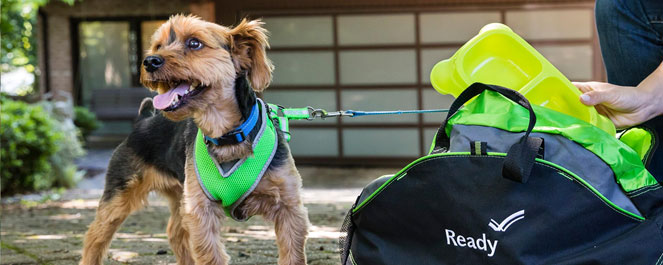The New Normal
I call my father-in-law “Mr. Safety.” In preparation for the millennium he gave each of his kids a Y2K survival kit, in case the world shut down at midnight like many predicted. The survival kit weighed a ton and we had no space for it in our tiny studio apartment. We laughed at the contents, as if we’d ever need a week’s worth of astronaut food. Eventually, a very large family of mice found the survival kit and had a millennial Y2K party of their own. Fast forward twenty years later, I now know that you can never be too prepared! Making an emergency disaster plan does not make you an alarmist or a pessimist. In fact, proper preparation may someday save your life and/or the life of your pet. Disasters are happening in greater frequency and intensity than ever before. In Northern California, wildfires have devastated our communities again and again over the past few years. We may not know when or where a disaster will strike but having a predetermined plan is essential for both your family and your pets. Having a pet disaster plan will help you remain calm and think clearly in the event that you need to evacuate in a hurry. Let’s go over the most important tips identified by Ready.gov which pet owners can do right now to prepare for an emergency situation.

Stay Informed
- Know what kind of disasters are more likely to affect your area and what times of year they are more likely to occur.
- Ready.gov suggests that you Download the FEMA app and get weather alerts from the National Weather Service for up to five different locations anywhere in the United States.
- Keep a NOAA Weather Radio tuned to your local emergency station and monitor TV, radio and follow mobile alert and mobile warnings about severe weather in your area.
- Remember to communicate and cooperate with all emergency personnel.
- If you must leave the premises let someone know where you are going and try to remain in contact with that person
Build a Kit
Every household should have an emergency bag ready to go for both humans and pets. It may be unrealistic to keep a pet emergency kit right next to your front door all year long, but I suggest keeping one close by during predictably high-risk times such as Fire Season in Sonoma County. Start with this list or download this Pet Emergency Preparedness Kit List from Ready.gov for a complete list of things your pet will need in an emergency.
Your kit should include:
- Food (at least a three-day supply in an airtight, waterproof container)
- Water (at least three days of water specifically for your pets)
- Medicines
- Medical records, proof of vaccinations, registration and adoption documents (talk to your veterinarian about microchipping)
- First aid kit (cotton bandage rolls, bandage tape and scissors, antibiotic ointment, flea and tick prevention, latex gloves, isopropyl alcohol, saline solution and a pet first aid reference book)
- Collar or harness with ID tag, rabies tag and a leash
- Crate or pet carrier (a sturdy, safe crate or carrier large enough for your pet to stand, turn around and lie down)
- Sanitation needs (litter box and litter, newspapers, paper towels, plastic trash bags and household chlorine bleach)
- A picture of you and your pet together to prove ownership (add species, breed, age, sex, color and distinguishing characteristics)
- Familiar items (treats, toys and bedding can help reduce stress for your pet)
Plan
Emergencies require us to make difficult decisions. In the face of sudden evacuation, some of my clients had to leave their pets behind risking loss, injury or worse. Others refused to evacuate without their pets so stayed behind with their animals and placed themselves at risk of injury or death. Both situations can be avoided by planning to evacuate with your pets.
This may sound like an impossible task, especially if you do not travel much with your animals. Here are a few things you can do now to make this an easier option in the event of an emergency evacuation.
- Practice putting your pet in their carrier and/or getting them into the car and going on car rides. The more you do this the easier it will be if you need to do it in a hurry.
- gov encourages pet owners to create a buddy system. Identify one person or neighbor to help you evacuate your pet if you are not home during the emergency evacuation or if you physically need help getting your pet into your car safely. A buddy system can also be helpful in your neighborhood to make sure all animals are taken care of in the event of an emergency. Everyone in the buddy system should have each other’s contact information, pet information and a clear plan for how these situations will ideally be handled if a disaster does take place.
- Plan where you and your pet will go in the event of an emergency evacuation. Make a list of pet-friendly hotels ahead of time and keep the list in your emergency kit. Know your local radio stations and your community’s social media pages for real time places you can safely evacuate to with your pet. Lastly, you can always try contacting a kennel or veterinarian near your local evacuation center if sheltering with your pet is not an option.
Additional Resources
- gov Pet Preparedness Toolkit
- AVMA Pets and Disasters resource
- AVMA Wildfire Smoke and Animals
- Preparing Makes Sense for Pet Owners-Emergency Preparedness Pet Kit List (PDF)
- Preparing makes sense for Pet owners(Video)
- Download the FEMA app
- Client Handout from Today’s Veterinary Practice
- Pet Preparedness Kit Checklist
- Large Animal and Livestock Preparedness





Leave A Comment